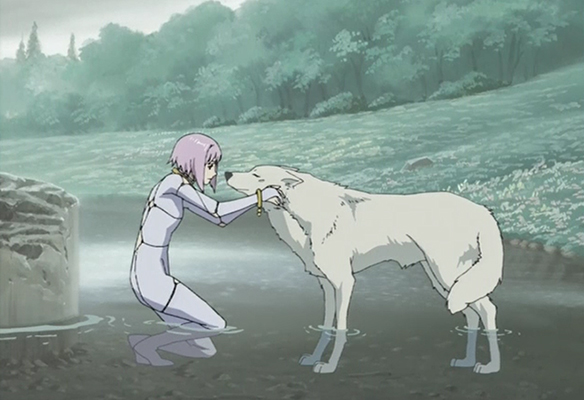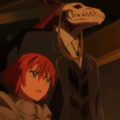Listed! By The Numbers – 12 Anime That Appealed To Me as a Furry, Part 1

As long as I’ve been into anime, I’ve also been into furry. (Though gaming will always remain my first love.) There are times when I’ve watched an anime movie or a series just because it appealed to me as a furry. Other times, I’ve watched a show and was pleasantly surprised to find furry elements. Although I’ve learned over the years that just because a show has furry appeal doesn’t always mean I’ll enjoy it. As a result there are a few entries on this list that I didn’t finish because I simply didn’t enjoy the show or movie.
For my sanity, I’ve split this list into two parts. Look forward to reading the second half next week. And yes, this article was penned because Geoff is not streaming. Send your ire or thanks his way.

1. Ringing Bell| Production Company: Sanrio | Year Released: 1978
I don’t remember who or what originally clued me into Ringing Bell, also known as Chirin no Suzu. Perhaps it was a discussion of Arashi no Yori Ni (another series I need to see), or maybe it was a random anime discussion among other furries. Either way, I’m glad I saw Ringing Bell as an adult and not as a child. The emotional themes and the dark ending would have absolutely rocked me as a kid. Not unlike how the final episode and ending of Mighty Max really depressed me.
Ringing Bell is the story of a little lamb named Chirin. One day his flock is attacked by a lone wolf who kills his mother as she tries to protect him. Chirin vows to take revenge on the wolf by becoming a wolf.
The idea of a lamb getting revenge on a wolf by becoming a wolf is utterly ridiculous, but it works in a cool, terrifying way. Impressed by the young lamb’s gumption, the wolf ends up becoming a father-like figure. He helps Chirin train for two years, until the young lamb grows into a fearsome ram. Though I will say it was an interesting stylistic choice by the character designers at Sanrio to give Chirin straight bull horns instead of curved ram horns. Chirin becomes like the beast he once feared and forgets about his vow for revenge. The two roam the countryside killing everything in their path. One night the young ram is tasked with killing his former flock, and watching a mother protect her lamb brings back repressed trauma.
At the end of the day, Ringing Bell is an allegory about the futility of revenge. Through its themes, it makes the point that when one walks the path of revenge, they often become like the monster they sought to slay. Worse yet, if that goal is accomplished, will the people from their former life even recognize the person they’ve become? It’s not an overly complicated story, and despite its dark nature, it is a tale aimed at children. Which explains the choice of giving Chirin a human-like face on a sheep’s body– instead of cute, I find it unsettling. Life lessons for children aside, I imagine the shock of adult Chirin looking downright demonic combined with the bitter ending probably left a lot of children disturbed.
The entire movie can easily be found on YouTube. I’d recommend the subtitled version over the English dub, but I’ve only been able to find the dub on YouTube. It looks like the only way to see the subtitled version is to obtain the movie on DVD which seems to be out of print.

2. Sherlock Hound | Production Company: TMS Entertainment | Year Released: 1984
At first glance I was all in on Sherlock Hound. It had that nice anime furry aesthetic that I love, and I don’t hate the world of Sherlock Holmes. Some episodes were even directed by the legendary Hayao Miyazaki. This classic 1980s anime was also conveniently streaming on Crunchyroll. Despite everything this series had going for it, this anime wasn’t really to my liking. I only managed to get a handful of episodes in before I dropped Sherlock Hound out of sheer boredom.
Sherlock Hound along with his assistant Watson, and their housemaid Mrs. Hudson solve mysteries. More often than not, the mastermind behind these crimes are the thieving Professor Moriarty and his gang.
Not even the furry aspects could rescue Sherlock Hound for me. The concept of Sherlock Holmes except they’re all anthropomorphic canines sounds great on the surface, but I wasn’t feeling the execution. To be fair, I was expecting a suspense thriller mystery in a vein similar to The Great Mouse Detective, or the comparatively newer Moriarty the Patriot. Instead, I received a series that moved far too slow for my liking, despite the nice animation and cool character designs. The show is beloved by anime fans and furries alike, and it even received a home video license rescue from Discotek. I feel like I should give this show another shake, and perhaps wipe the slate clean having a better idea of what to expect from Sherlock Hound. (On a side note, I’m curious as to why Sherlock keeps being referred to as a fox in search results when he’s clearly a dog.)

3. Silver Fang: The Shooting Star Gin | Production Company: Toei Animation | Year Released: 1986
Silver Fang: The Shooting Star Gin is also known as Ginga: Nagareboshi Gin, though I’ve mostly always known it as Silver Fang. It was a series that I’d heard about for years in furry circles before I actually had a chance to see it for myself. The only western release this show saw was in a variety of Nordic countries. North America was left out in the cold, and the only way to watch this series in English was to go sailing the high seas for fan subs. This is exactly how I saw this series, but it took the 2006 anime sequel Ginga Densetsu Weed to kick off fansubber interest. Until I had a chance to check out and download the fan subs, I only knew about Silver Fang because of European fans and occasional references to it from other anime such as Excel Saga.
In the countryside of Japan life is rough. Futago Pass has been overrun by bears, lead by a large, powerful bear named Akakabuto. This particular bear has a taste for human flesh and is adept at avoiding hunters. Aided by their bear dogs (Akita Inu), various hunters have tried and failed to slay Akakabuto. While out on the hunt, an older hunter named Takeda and his tiger-striped bear dog named Riki are out looking for the bear. Meanwhile, at home Riki’s mate, Fuji gives birth to puppies. One of them has tiger stripes just like his father.
Before Daisuke, Takeda’s grandson, can tell his grandfather about the puppies, the hunter and his dog are lost for a week in a fierce blizzard. During that time the hunting party they’re with is killed by the violent bear. Once the storm clears, Daisuke sets out to find Takeda and Riki, taking Gin with him. The boy finds Riki doing battle with the bear. For a brief moment, Riki meets his son, Gin. In the heat of battle, Riki falls off a cliff and Akakabuto disappears into the snow. Takeda and Daisuke raise Gin as a bear dog. As an older puppy, Gin leaves home, having found a large pack of wild dogs gathered together by Riki in order to kill Akakabuto once and for all.
The first few episodes of Silver Fang take place from the humans’ point of view. Not unlike Iron Will or Call of the Wild. The hunters are determined to kill Akakabuto, and you get the sense that having lost Riki, Gin will take his father’s place either at Daisuke’s side or with Takeda someday. Then partway through episode seven, the entire genre and perspective shifts. Gin and another hunting dog, a German Shepard named John, leave their masters behind to follow a large pack of wild dogs.
The dogs who have until this point only communicated with barks, whines, and yips, suddenly have voices. Silver Fang is now completely told from their perspective and we the audience are privy to their thoughts as well. The humans are left in the literal and figurative dust as the dogs decide to handle the bear problem in Futago Pass by themselves. What follow is largely a story about leadership struggles, factions among the dogs, and a leader who doesn’t even remember his own son thanks to a nasty fall from a cliff months earlier.
In addition to covering themes found in a lot of xenofiction, Silver Fang is also a modern retelling of the epic battles of the Warring States Period in Japan. The dogs are effectively warlords in their struggle for dominance over the land. Before the battles between Akakabuto and his forces occur, the dogs have to unite their own forces. Sure, Riki has gathered a large army to fight, but there are rival armies, factions, and would be usurpers. Among this turmoil, Gin has to find his own place among these dogs. Besides, fighting dogs, Silver Fang has some of the wildest animal fights I’ve seen in an anime. Only in this series can dogs climb trees easier than any cat, dash at damn near the speed of light, and spin fast enough in midair to decapitate bears.

4. Inuyasha | Production Company: Sunrise | Year Released: 2000
I was one of the many anime fans who found Inuyasha thanks to its initial run on Adult Swim from 2002 to 2006. What initially caught my eye wasn’t the mild furry aesthetics the series had going on (thought hey certainly didn’t hurt), but the fact that it was a Rumiko Takahashi series. I had already been somewhat familiar with Ranma 1/2 because I had the opportunity to rent parts of it on VHS tape in late 2001. Thanks to these rentals I was only able to see the first season. Those brief 20 something episodes gave me a taste for Takahashi’s style and sense of humor. All I needed to know was that Inuyasha was from the same creator to be on board.
In feudal Japan, Inuyasha is a young man who’s also half dog demon. He’s in the process of stealing a powerful relic known as the Shikon Jewel from a village. The villagers try to stop him, but he’s easily able to overwhelm them and break free of their traps. Once he has the Shikon Jewel in his possession, he tries to flee the village, but is stopped by the powerful priestess, Kikyo. A single shot from her sacred arrow pierces Inuyasha’s heart, pins him against a tree, and puts him to sleep forever. Wounded earlier, Kikyo succumbs to her injuries. Her final wishes are to be burned at pyre along with the dangerous jewel.
In modern Japan on one fateful day, first year high school student Kagomi Higurashi goes down into the family well in search of the family cat. In the well, a burst of light appears and numerous hands reach out to pull Kagomi into the light. She’s transported through space and time and ends up in feudal Japan. There she finds a curious sight. A young man with dog ears pinned to a tree and in a deep slumber. Before she can investigate further, she’s detained by the villagers, curious about her strange clothing. Later that night, the same demon who pulled her into the light attacks the village, looking for the Shikon Jewel, which suddenly manifests when the demon attacks Kagomi, drawing her blood. She’s led to the tree, where Inuyasha is suddenly awake. If she frees him, he’ll kill the demon and save the villagers. Desperate, Kagomi complies and frees the half demon.
What originally caught me off guard about Inuyasha was the number of furry elements present in the series. And no, I don’t mean the characters with animal ears, but actual full on anthropomorphic characters, and other characters that can fully transform into gigantic animals. They were a fun bonus in an action series stuffed to the brim with Japanese mythology, and a fun sense of adventure. Having seen some of Takahashi’s prior works, including Urusei Yatsura, I can see how many fans would view this show as a huge departure from her previous works. While there is humor, this anime is a solid action show versus a situational comedy.
My only complaint is that at 167 episodes, it felt like Inuyasha wore out its welcome. This was at a time when filler episodes were a thing, even if this show was spared the indignation of full filler seasons. It was a bit depressing to see the series ultimately cancelled. Fortunately, the anime did receive a proper send off with the 2009 adaptation of the final part of the manga. Even years later, Inuyasha remains one of my favorite low-key furry anime series, and an absolute favorite from the Takahashi series I’ve had the pleasure of watching. And no, I’m not acknowledging Yashahime.

5. Wolf’s Rain| Production Company: Bones | Year Released: 2003
Wolf’s Rain was another series I got into via sailing the high seas. I actually discovered the existence of this anime via a news article link shared on LiveJournal. I learned a lot of the staff from Cowboy Bebop would be working on this show, so I had to check out. I was also intrigued by the title and how the series would involve wolves. What followed was one of the most unique anime series I’ve had the pleasure of watching. As a bonus, it had great appeal among regular anime fans and furries. Watching both fandoms collide and have their own takes on this series was fascinating.
Wolves have been extinct for over two hundred years, or so the legends say. Not that it matters because in this futuristic dystopia, humanity is on the very edge of extinction, as much of the world is a frozen wasteland. Humans live in domed cities and factions led by powerful nobles fight each other. In reality, wolves aren’t actually extinct. They just blended in with humans by disguising themselves as humans to move about freely. Except for one particular white wolf named Kiba. One day he wanders into a city, in search of the Lunar Flowers that are supposed to guide wolves to paradise.
Instead, he gets into a fight with a local gang leader named Tsume (who’s actually a disguised wolf), and runs off. Later, Kiba gets himself captured and sent to a lab. He’s placed near a girl in suspended animation named Cheza, who smells of the Lunar Flowers that will lead him to paradise. A young man named Hige finds him to be curious, and berates the wolf. It turns out Hige is actually a wolf among humans, and offers to teach Kiba how to blend in. The white wolf wants to free Cheza so she’ll take them to paradise, but is persuaded to come back later after he escapes his cage. Meanwhile, Tsume meets a boy named Toboe, another glamoured wolf. Toboe joins Tsume’s human gang, and they go on a food raid.
Suddenly the facility housing Cheza is attacked, and she’s taken away by a noble named Darcia. Kiba and Hige decide to peruse the noble and along the way run into Toboe. The trio is set to leave the city and manage to convince Tsume to come with them. Together the four wolves set off to find Cheza, and ultimately paradise.
Wolf’s Rain is best described as a show where characters go on a journey to reach a destination, but the journey itself and the characters are more important. In that aspect, it shares a lot with Cowboy Bebop, down to its bittersweet ending. There is a lot happening in this anime, as it covers themes of death and rebirth, greed and selflessness. The main characters are wolves, but they spend so much time glamoured as humans that it’s possible to forget they are wolves. At least until the final set of episodes where finding paradise becomes a real possibility. Anyone going into the show expecting pure xenofiction on the furry side of the scale is going to be disappointed. Much of the time, the wolves appear as beautiful young men.
Wolf’s Rain is packed with symbolism. For people who like breaking down mythology and religious themes, this show is a treat. Though the middle of the show is somewhat middling at times, as the pace of the plot slows down. Fortunately, the last quarter of the show really picks up in terms of action. That said, Bones did suffer with some production issues. In a 30-episode show, there were four back-to-back recap episodes. Downloading the fan subbed show each week meant sitting through four weeks of episodes largely consisting of re-cut footage from previous episodes. Other than those dreaded recap episodes, Wolf’s Rain is excellent. It remains one of my absolute favorite series right alongside Cowboy Bebop.

6. Ginga Densetsu Weed| Production Company: Studio DEEN | Year Released: 2005
Ginga Densetsu Weed is another series I watched via fan subs as they were released by a fansubbing group each week. It really is amazing how things changed with the advent of streaming services versus downloads two decades ago. It’s also incredible to watch that needle drift back toward less than legal downloads. But, I digress. I saw Ginga Densetsu Weed before Silver Fang (thanks to the aforementioned fan sub situation), and I’m grateful for watching Weed first. Had I seen it after Silver Fang, I probably wouldn’t remember this series as fondly. It is a direct sequel, and takes place long after Gin has grown up and had puppies of his own. Like it’s predecessor, this anime was never released in North America, not even on streaming services. The only way to see this show is either on YouTube or the Internet Archive. (Fortunately, I still have those episodes I downloaded nearly 17 years ago.)
After Gin manages to defeat the terrible bear named Akakabuto, and freed Futago Pass, the years tick by and all the dogs live in peace in an area known as Ohu. After Riki’s passing, Gin became the leader of the dogs. 14 years pass and one day a monstrous dog invades Ohu while Gin and his closest subordinates are away. Smith flees with Gin’s partner, Sakura who’s pregnant. Along the way Sakura and Smith are separated, and six months go by. Sakura only has a single pup, who doesn’t even have a name. While foraging for food, a silver, tiger striped Akita Inu runs into GB, an English Setter. The pup steals his kill and GB eventually relents after learning the younger dog needs the food for his sick mother.
Later GB and his companion, Sasuke get into a scuffle with a farm dog, as they try to catch wild ducks. GB leaves Sasuke with the guard, and runs off. The Akita puppy implores him to help his friend. Gb ignores his pleas. So the puppy faces the guard dog, spurring the English Setter to help. They’re no match for the guard dog, but the Akita pup does use the Battouga, a move he inherited from his father. In the distance Smith sees this, scares off the guard god, and everyone reunites with Sakura. She’s dying from her illness and begs her son to find his father, Gin. After Sakura passes, the group heads to Ohu and GB names the Akita puppy “Weed.”
Unlike Silver Fang, Weed begins immediately from the perspective of the dogs. There’s also more action to boot as fights between the dogs are common. This sequel largely follows some of the same tropes from its predecessor, but other dogs are now the enemy instead of bears. For example, not long after the monster dog occupying Ohu is dispatched, another dog leading his own army moves into Ohu. The show becomes Weed’s struggle to find his own allies in order to take back his father’s territory. Gin is very much a presence in this show, but he’s largely sidelined, thanks to the greater enemy.
Weed is a solid xenofiction action show. While Weed himself is quite annoying, especially compared to Gin, I enjoyed this sequel. That said, the animation is absolutely subpar. A few episodes are nicely animated, but the vast majority of them are eyesores at best. It felt like no one at Studio DEEN could be bothered to properly animate a dog or keep any of them on model. This is doubly worse, when you compare this show to the 1986 prequel animated by Toei. Sure, that production had issues, but at least everyone largely stayed on model. Amazingly, Toei captures Gin being a silver dog with tiger stripes, where Gin and Weed are both an odd shade of blue for the newer series and there’s not a stripe to be found on their bodies.
Ginga Densetsu Weed is a perfectly acceptable show and the numerous fights were fun to watch. That said, the bad animation and off-model characters spoiled some of my enjoyment.
After a painstaking 3600 words, I think it’s time to call it a night here. I’ll be back next Sunday with the second half that covers the late aughts up until the 2020s.
Until then, are there are shows you think I should have covered? What are some of your favorite anime that feature furry elements you like?
Related posts:
About The Author
Angela
Executive Editor | Angela has had an addiction to video games and cartoons since she was young and impressionable. She enjoys writing long articles about these subjects and whatever else catches her eye. Mastodon
Add a Comment
Cancel reply
This site uses Akismet to reduce spam. Learn how your comment data is processed.





Amazingly, I made this list, mentioned Hayao Miyazaki, but completely forgot to add Princess Mononoke. If there’s time, I might have to add a missed/honorable mentions section to next week’s part two.